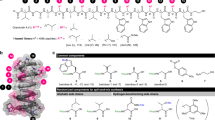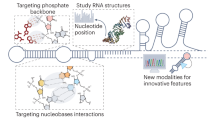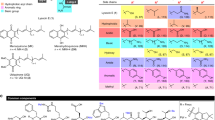Abstract
The ability to rapidly identify small molecules that interact with RNA would have significant clinical and research applications. Low-molecular-weight molecules that bind to RNA have the potential to be used as drugs. Therefore, technologies facilitating the rapid and reliable identification of such activities become increasingly important. We have applied a fluorescence-based assay to screen for modulators of hammerhead ribozyme (HHR) catalysis from a small library of antibiotic compounds. Several unknown potent inhibitors of the hammerhead cleavage reaction were identified and further characterized. Tuberactinomycin A, for which positive cooperativity of inhibition in vitro was found, also reduced ribozyme cleavage in vivo. The assay is applicable to the screening of mixtures of compounds, as inhibitory activities were detected within a collection of 2,000 extracts from different actinomycete strains. This approach allows the rapid, reliable, and convenient identification and characterization of ribozyme modulators leading to insights difficult to obtain by classical methodology.
This is a preview of subscription content, access via your institution
Access options
Subscribe to this journal
Receive 12 print issues and online access
$209.00 per year
only $17.42 per issue
Buy this article
- Purchase on Springer Link
- Instant access to full article PDF
Prices may be subject to local taxes which are calculated during checkout




Similar content being viewed by others
References
Gait, M.J. & Karn, J. RNA recognition by the human immunodeficiency virus Tat and Rev proteins. Trends Biochem. Sci. 18, 255–259 ( 1993).
Hermann, T. & Westhof, E. RNA as a drug target: chemical, modelling, and evolutionary tools. Curr. Opin. Biotechnol. 9, 66–73 (1998 ).
Afshar, M., Prescott, C.D. & Varani, G. Structure-based and combinatorial search for new RNA-binding drugs. Curr. Opin. Biotechnol. 10, 59– 63 (1999).
Ecker, D.J. & Griffey, R.H. RNA as a small-molecule drug target: doubling the value of genomics. Drug Discovery Today 4, 420–429 ( 1999).
Woodcock, J., Moazed, D., Cannon, M., Davies, J. & Noller, H.F. Interaction of antibiotics with A- and P-site-specific bases in 16S ribosomal RNA. EMBO J. 10, 3099–3103 (1991).
Zapp, M.L., Stern, S. & Green, M.R. Small molecules that selectively block RNA binding of HIV-1 Rev protein inhibit Rev function and viral production. Cell 74, 969–978 ( 1993).
Wang, S., Huber, P.W., Cui, M., Czarnik, A.W. & Mei, H.Y. Binding of neomycin to the TAR element of HIV-1 RNA induces dissociation of Tat protein by an allosteric mechanism . Biochemistry 37, 5549– 5557 (1998).
Wang, Y., Hamasaki, K. & Rando, R.R. Specificity of aminoglycoside binding to RNA constructs derived from the 16S rRNA decoding region and the HIV-RRE activator region . Biochemistry 36, 768– 779 (1997).
Walter, F., Vicens, Q. & Westhof, E. Aminoglycoside–RNA interactions. Curr. Opin. Chem. Biol. 3, 694–704 (1999).
Schroeder, R., Waldsich, C. & Wank, H. Modulation of RNA function by aminoglycoside antibiotics. EMBO J. 19, 1– 9 (2000).
Hermann, T. & Westhof, E. Aminoglycoside binding to the hammerhead ribozyme: a general model for the interaction of cationic antibiotics with RNA. J. Mol. Biol. 276, 903–912 (1998).
Murray, J.B. & Arnold, J.R. Antibiotic interactions with the hammerhead ribozyme: tetracyclines as a new class of hammerhead inhibitor . Biochem. J. 317, 855– 860 (1996).
Clouet-d'Orval, B., Stage, T.K. & Uhlenbeck, O.C. Neomycin inhibition of the hammerhead ribozyme involves ionic interactions. Biochemistry 34, 11186–11190 (1995).
Stage, T.K., Hertel, K.J. & Uhlenbeck, O.C. Inhibition of the hammerhead ribozyme by neomycin . RNA 1, 95–101 (1995).
Michael, K. & Tor, Y. Designing novel RNA Binders . Chemistry Eur. J. 4, 2091– 2098 (1998).
Scott, W.G., Murray, J.B., Arnold, J.R.P., Stoddard, B.L. & Klug, A. Capturing the structure of a catalytic RNA intermediate: the hammerhead ribozyme. Science 274, 2065–2069 ( 1996).
Pearson, N.D. & Prescott, C.D. RNA as a drug target . Chem. Biol. 4, 409–414 (1997).
Stage-Zimmermann, T.K. & Uhlenbeck, O.C. Hammerhead ribozyme kinetics. RNA 4, 875– 889 (1998).
Tor, Y. RNA and the small molecule world. Angew. Chem. Int. Edn. 38, 1579–1582 (1999).
Noller, H.F. Ribosomes. Drugs and the RNA world. Nature 353, 302–303 (1991).
Rogers, J., Chang, A.H., von Ahsen, U., Schroeder, R. & Davies, J. Inhibition of the self-cleavage reaction of the human hepatitis delta virus ribozyme by antibiotics. J. Mol. Biol. 259, 916–925 (1996).
Neu, H.C. The crisis in antibiotic resistance. Science 257, 1064–1073 (1992).
Davies, J. & Wright, G.D. Bacterial resistance to aminoglycoside antibiotics. Trends Microbiol. 5, 234–240 (1997).
Davies, J. Inactivation of antibiotics and the dissemination of resistance genes. Science 264, 375–382 ( 1994).
Jenne, A., Gmelin, W., Raffler, N. & Famulok, M. Real-time characterization of ribozymes by fluorecence resonance energy transfer (FRET). Angew. Chem. Int. Edn. 38, 1300–1303 (1999).
Singh, K.K., Parwaresch, R. & Krupp, G. Rapid kinetic characterization of hammerhead ribozymes by real-time monitoring of fluorescence resonance energy transfer (FRET). RNA 5, 1348–1356 ( 1999).
von Ahsen, U., Davies, J. & Schroeder, R. Non-competitive inhibition of group I intron RNA self-splicing by aminoglycoside antibiotics. J. Mol. Biol. 226, 935–941 ( 1992).
Hoch, I., Berens, C., Westhof, E. & Schroeder, R. Antibiotic inhibition of RNA catalysis: neomycin B binds to the catalytic core of the td group I intron displacing essential metal ions. J. Mol. Biol. 282, 557–569 ( 1998).
Mikkelsen, N.E., Brannvall, M., Virtanen, A. & Kirsebom, L.A. Inhibition of RNase P RNA cleavage by aminoglycosides . Proc. Natl. Acad. Sci. USA 96, 6155– 6160 (1999).
Earnshaw, D.J. & Gait, M.J. Hairpin ribozyme cleavage catalyzed by aminoglycoside antibiotics and the polyamine spermine in the absence of metal ions. Nucleic Acids Res. 26 , 5551–5561 (1998).
Zhu, K., Henning, D., Iwakuma, T., Valdez, B.C. & Busch, H. Adriamycin inhibits human RH II/Gu RNA helicase activity by binding to its substrate. Biochem. Biophys. Res. Commun. 266, 361–365 (1999).
Dassonneville, L., Hamy, F., Colson, P., Houssier, C. & Bailly, C. Binding of Hoechst 33258 to the TAR RNA of HIV-1. Recognition of a pyrimidine bulge-dependent structure . Nucleic Acids Res. 25, 4487– 4492 (1997).
Mestre, B. et al. Oligonucleotide inhibition of the interaction of HIV-1 Tat protein with the trans-activation responsive region (TAR) of HIV RNA. Biochim. Biophys. Acta 1445, 86–98 (1999).
Werstuck, G. & Green, M.R. Controlling gene expression in living cells through small molecule–RNA interactions. Science 282, 296–298 ( 1998).
Bailly, C., Colson, P., Houssier, C. & Hamy, F. The binding mode of drugs to the TAR RNA of HIV-1 studied by electric linear dichroism. Nucleic Acids Res. 24, 1460– 1464 (1996).
Pilch, D.S., Kirolos, M.A., Liu, X., Plum, G.E. & Breslauer, K.J. Berenil [1,3-bis(4′-amidinophenyl)triazene] binding to DNA duplexes and to a RNA duplex: evidence for both intercalative and minor groove binding properties. Biochemistry 34 , 9962–9976 (1995).
Samarsky, D.A. et al. A small nucleolar RNA:ribozyme hybrid cleaves a nucleolar RNA target in vivo with near-perfect efficiency. Proc. Natl. Acad. Sci. USA 96, 6609–6614 ( 1999).
Rossi, J.J. Ribozymes in the nucleolus. Science 285, 1685 (1999).
Samarsky, D.A., Fournier, M.J., Singer, R.H. & Bertrand, E. The snoRNA box C/D motif directs nucleolar targeting and also couples snoRNA synthesis and localization. EMBO J. 17, 3747–3757 (1998).
Acknowledgements
We thank Barbara Waters and TerraGen Discovery for providing the actinomycete extracts and Abbott Laboratories for chelocardin, E. Bertrand, E. Westhof, and the members of the Famulok laboratory for helpful discussions, and M.J. Fournier for sharing the strategic approach of the in vivo cleavage assay. This work was supported by the Deutsche Forschungsgemeinschaft, Aventis GenCell (to M.F. and N.P.), and the H. Arthur Smith Foundation for Cancer Research (to D.A.S.).
Author information
Authors and Affiliations
Corresponding author
Additional information
Note: Supplementary information can be found on the Nature Biotechnology website in http://biotech.nature.com/web_extras.
Supplementary information
Rights and permissions
About this article
Cite this article
Jenne, A., Hartig, J., Piganeau, N. et al. Rapid identification and characterization of hammerhead-ribozyme inhibitors using fluorescence-based technology. Nat Biotechnol 19, 56–61 (2001). https://doi.org/10.1038/83513
Received:
Accepted:
Issue Date:
DOI: https://doi.org/10.1038/83513
This article is cited by
-
Modulating RNA structure and catalysis: lessons from small cleaving ribozymes
Cellular and Molecular Life Sciences (2009)
-
Exogenous control of mammalian gene expression through modulation of RNA self-cleavage
Nature (2004)
-
Protein-dependent ribozymes report molecular interactions in real time
Nature Biotechnology (2002)



